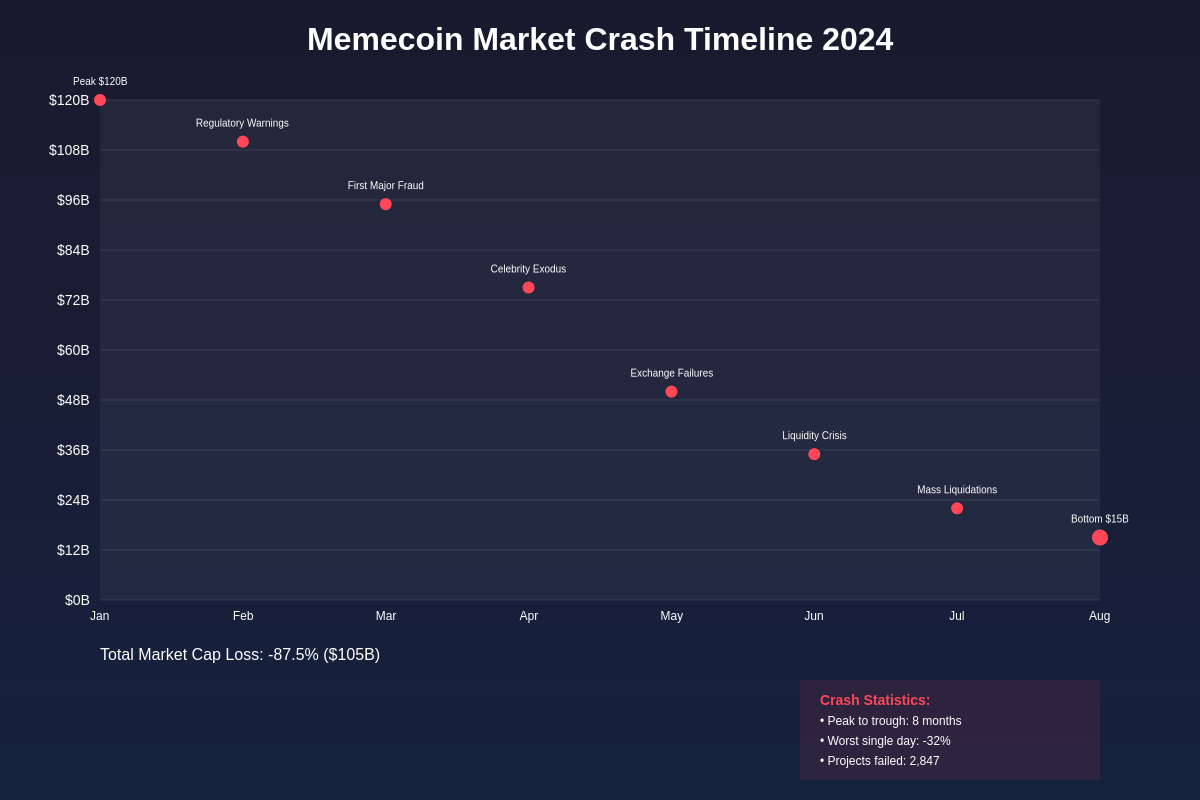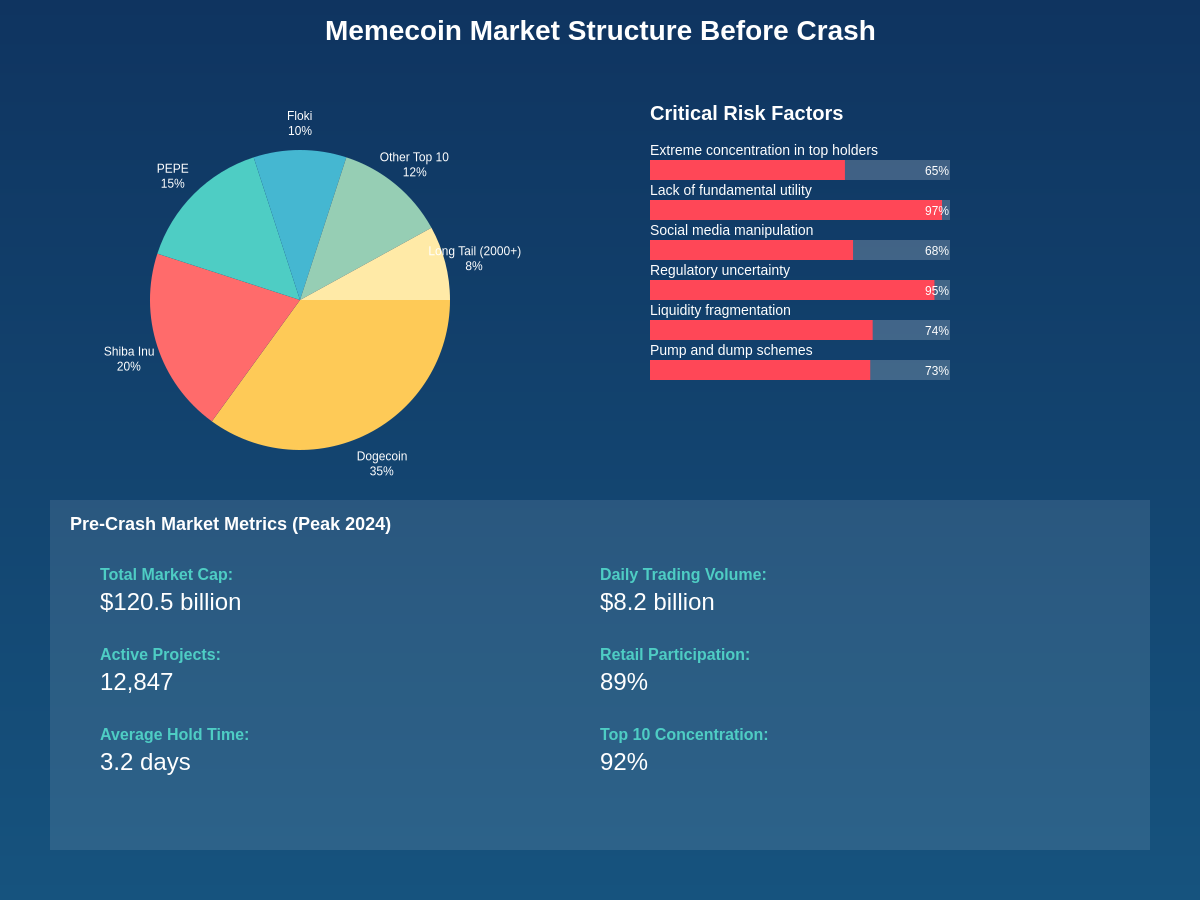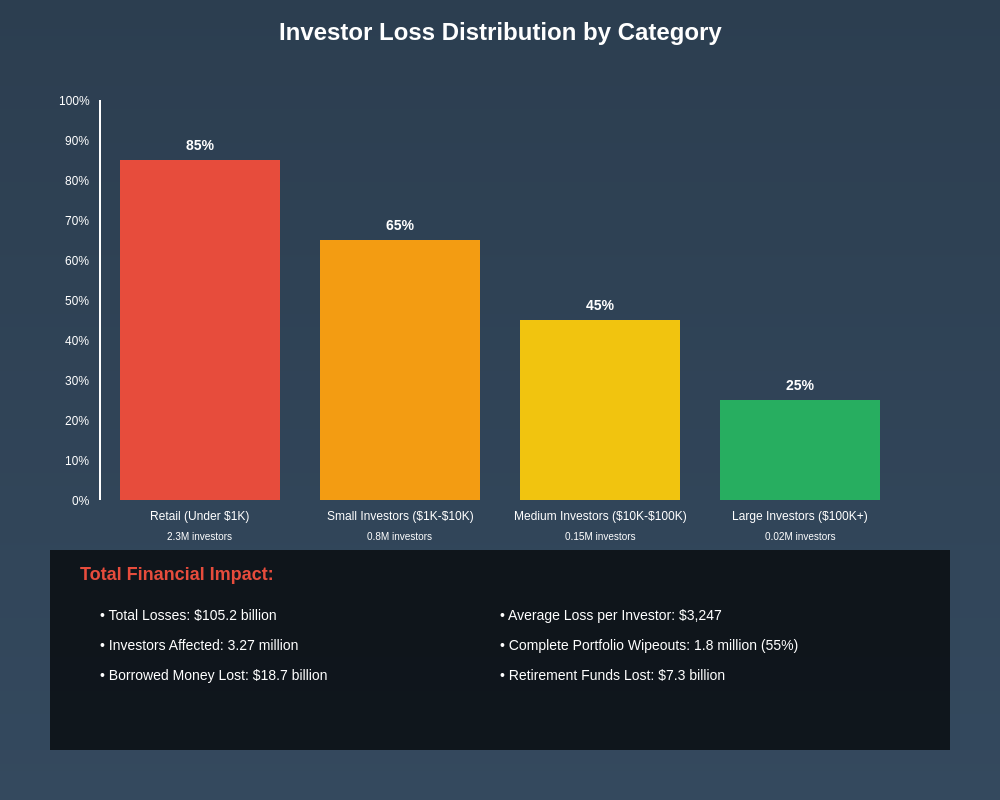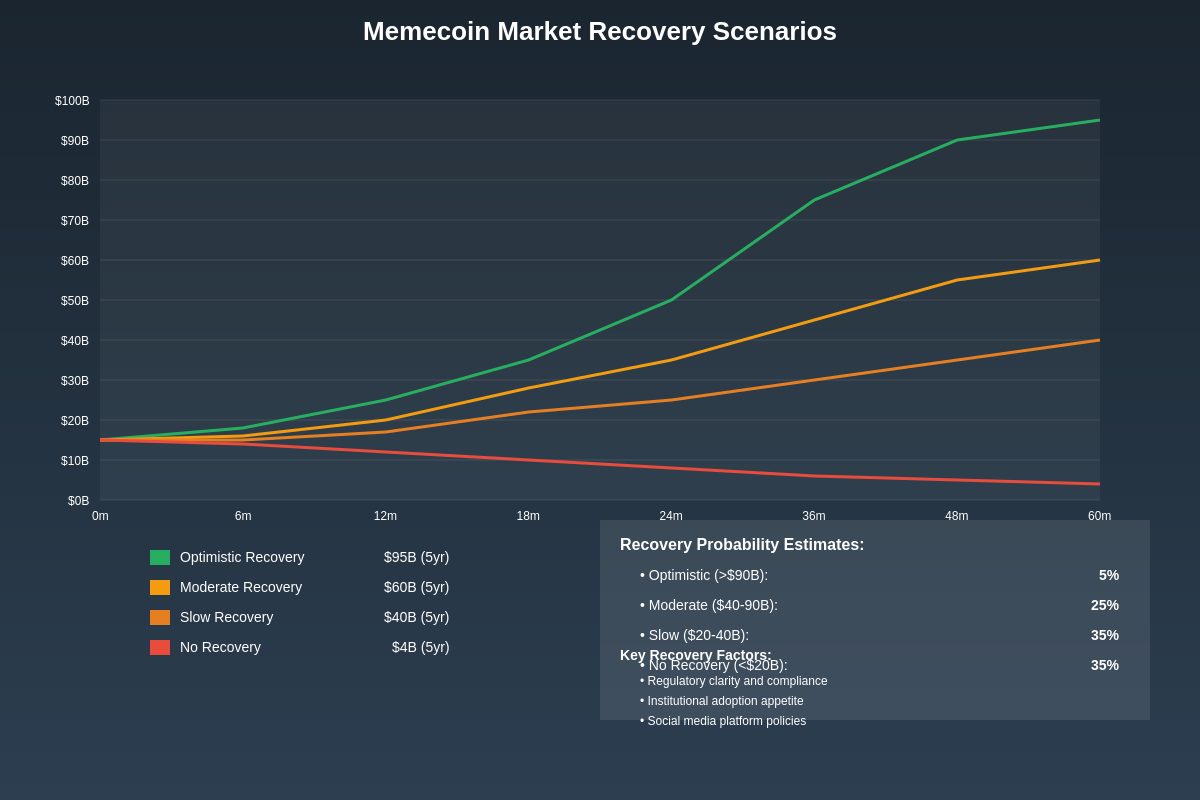The Great Memecoin Collapse
The memecoin market experienced a catastrophic collapse during 2024, with combined market capitalizations falling from peak valuations of over $120 billion to less than $15 billion within the span of just eight months. This dramatic crash wiped out trillions of dollars in paper wealth and left millions of retail investors facing devastating losses as speculative tokens that had promised revolutionary returns delivered nothing but financial ruin. The memecoin crash of 2024 represents one of the most significant wealth destruction events in cryptocurrency history, fundamentally altering the landscape of digital asset speculation and forcing a reckoning with the unsustainable dynamics that had driven the meme token phenomenon to unprecedented heights.

Start your technical analysis journey with TradingView’s comprehensive Pine Script documentation to better understand market patterns and volatility indicators that could have predicted this crash.
The scale of the memecoin crash defied even the most pessimistic predictions from traditional financial analysts who had long warned about the speculative nature of meme-based cryptocurrencies. What began as isolated sell-offs in smaller tokens quickly cascaded into a market-wide panic that consumed even the most established memecoin projects, revealing the interconnected nature of speculative cryptocurrency markets and the fragility of assets built primarily on social media hype rather than fundamental utility or technological innovation.
Historical Context and the Rise of Meme Tokens
Understanding the memecoin crash of 2024 requires examining the extraordinary bull run that preceded it, a period marked by unprecedented retail participation, social media-driven investment decisions, and the emergence of a new generation of cryptocurrency investors who prioritized viral content over traditional financial metrics. The memecoin phenomenon had its roots in early experiments like Dogecoin, which began as a lighthearted parody of Bitcoin but evolved into a legitimate cryptocurrency with real-world utility and adoption.
The transformation of memecoins from internet jokes into serious investment vehicles occurred gradually throughout the early 2020s, accelerated by factors including widespread retail adoption of cryptocurrency trading platforms, the gamification of investment through social media, and the emergence of influential online personalities who promoted meme tokens to massive audiences. The TradingView platform became an essential tool for tracking the explosive price movements that characterized the memecoin boom.
The regulatory environment surrounding memecoins contributed significantly to their proliferation, as the lack of clear guidelines enabled projects to launch with minimal oversight while retail investors faced limited protections against fraudulent schemes or market manipulation. This regulatory vacuum created an ecosystem where virtually anyone could create and promote a memecoin with minimal technical knowledge or financial resources, leading to an explosion in the number of meme-based tokens and increasingly sophisticated marketing campaigns designed to attract retail investment.
Social media platforms played a crucial role in amplifying memecoin speculation, with algorithms optimized for engagement inadvertently promoting high-risk investment content to users who lacked the experience or knowledge to evaluate the risks involved. The viral nature of meme content created feedback loops where successful memecoins generated more social media attention, which in turn attracted more investors and drove prices higher, creating unsustainable speculative bubbles that were destined to collapse once the flow of new investors slowed.
Market Dynamics and Speculative Behavior
The memecoin market of 2024 was characterized by extreme volatility, irrational price movements, and speculative behavior that defied traditional financial analysis and risk management principles. Unlike established cryptocurrencies with clear utility propositions or technological innovations, memecoins derived their value primarily from social sentiment, celebrity endorsements, and viral marketing campaigns that could generate massive price movements within hours or days.

The concentration of memecoin holdings among a small number of early investors and project creators created significant risks for retail participants, as large holders possessed the ability to manipulate prices through coordinated buying and selling activities. Many memecoin projects featured tokenomics designed to benefit insiders at the expense of later investors, with mechanisms including developer allocations, founder rewards, and hidden premines that enabled project creators to extract value while retail investors bore the majority of downside risk.
Liquidity provision in memecoin markets often relied on automated market makers and decentralized exchanges that lacked the depth and stability of traditional financial markets, creating conditions where relatively small trades could generate massive price swings and where exit liquidity could disappear rapidly during periods of market stress. The real-time charting capabilities available through professional trading platforms revealed the extreme volatility and liquidity challenges that characterized memecoin markets.
The psychological factors driving memecoin speculation included fear of missing out on massive gains, social proof from online communities, and the gamification of investment through meme culture and social media engagement. Many retail investors treated memecoin trading as entertainment rather than serious investment activity, leading to poor risk management decisions and excessive leverage that amplified losses when market conditions deteriorated.
Cross-market correlations between different memecoins created systemic risks that were not immediately apparent to retail investors who believed they were diversifying their holdings by purchasing multiple meme tokens. When market sentiment shifted negative, these correlations meant that losses in one memecoin project often triggered selling pressure across the entire category, creating cascading liquidations and accelerating the pace of the overall market collapse.
Catalyst Events and Market Triggers
The memecoin crash of 2024 was precipitated by a series of catalyst events that shattered investor confidence and triggered a massive flight from speculative cryptocurrency investments toward safer assets and traditional financial instruments. The first major catalyst occurred when regulatory authorities in several major jurisdictions announced coordinated investigations into memecoin projects suspected of securities violations, market manipulation, and fraudulent marketing practices.
High-profile fraud revelations involving prominent memecoin projects sent shockwaves through the entire ecosystem, as investigations revealed that many popular tokens had been created and promoted through elaborate schemes designed to extract value from retail investors while providing little to no legitimate utility or technological innovation. These revelations included evidence of wash trading, fake partnerships, and coordinated pump-and-dump schemes that had artificially inflated token prices and trading volumes.
The collapse of several major cryptocurrency exchanges that had been heavily involved in memecoin trading created liquidity crises that accelerated the downward spiral in token prices, as investors lost access to their holdings and new buyers disappeared from the market. These exchange failures revealed the interconnected nature of memecoin markets and the concentration risks associated with centralized trading platforms that lacked adequate reserves or risk management systems.
Macroeconomic factors including rising interest rates, increased regulatory scrutiny of cryptocurrency markets, and broader risk-off sentiment in global financial markets created an environment where speculative assets like memecoins became particularly vulnerable to selling pressure. The technical analysis tools available to professional traders had long shown warning signs of unsustainable price levels and momentum divergences that preceded the crash.
Celebrity and influencer withdrawals from memecoin promotion represented another critical catalyst, as many high-profile personalities who had previously endorsed meme tokens distanced themselves from the space following regulatory threats and public criticism. The loss of these promotional channels eliminated a key driver of retail interest and new investor acquisition that had been essential to maintaining memecoin price levels.
Technical Analysis and Warning Signs
Retrospective technical analysis of the memecoin market reveals numerous warning signs that were visible to experienced traders and analysts in the months leading up to the 2024 crash, though these signals were largely ignored by retail investors caught up in the speculative frenzy. Chart patterns across major memecoin projects showed classic signs of distribution, with increasing selling pressure from large holders even as prices continued to reach new highs supported by retail buying.
Volume analysis indicated declining participation from institutional investors and sophisticated traders, with trading activity becoming increasingly concentrated among retail participants who lacked the resources and expertise to sustain long-term price appreciation. The divergence between price action and underlying metrics such as developer activity, network usage, and genuine adoption provided clear signals that memecoin valuations had become disconnected from any fundamental value proposition.
On-chain analysis revealed troubling patterns including increasing centralization of token holdings, declining transaction activity adjusted for speculation, and growing numbers of dormant addresses that suggested many investors had already begun exiting positions well before the public crash became apparent. These metrics were available through professional analysis platforms but were largely overlooked by retail investors focused on price momentum and social media sentiment.
Technical indicators including relative strength index divergences, declining moving average support levels, and breakdown of key resistance levels provided clear sell signals for traders who understood traditional chart analysis principles. The comprehensive charting tools available through advanced trading platforms had been showing distribution patterns and momentum weakening for months before the crash accelerated.
Correlation analysis between memecoin prices and broader cryptocurrency markets showed increasing sensitivity to Bitcoin and Ethereum price movements, indicating that meme tokens were losing their independent momentum and becoming more vulnerable to broader market downturns. This correlation breakdown suggested that the narrative-driven price action that had characterized the memecoin boom was giving way to more traditional risk-off behavior among cryptocurrency investors.
Regulatory Response and Legal Implications
The regulatory response to the memecoin crash of 2024 was swift and comprehensive, with authorities across multiple jurisdictions implementing emergency measures designed to protect retail investors while establishing clearer guidelines for cryptocurrency projects claiming to offer investment opportunities. Securities regulators in major markets including the United States, European Union, and United Kingdom launched coordinated investigations into memecoin projects suspected of operating as unregistered securities offerings.
The legal implications of the memecoin crash extended beyond individual project investigations to include broader questions about platform liability, influencer responsibility, and the regulatory classification of meme-based digital assets. Courts in several jurisdictions ruled that certain memecoin projects constituted securities offerings subject to traditional financial regulations, establishing important precedents for future cryptocurrency projects and their marketing practices.
Criminal prosecutions resulted from investigations into fraudulent memecoin schemes, with authorities charging project creators, promoters, and in some cases exchange operators with securities fraud, wire fraud, and conspiracy charges. These prosecutions sent a clear message that the anonymity and decentralized nature of cryptocurrency markets would not protect bad actors from legal consequences when they engaged in fraudulent behavior targeting retail investors.
International cooperation between regulatory authorities improved significantly in response to the cross-border nature of memecoin fraud schemes, with agencies sharing information and coordinating enforcement actions against projects that had operated across multiple jurisdictions to evade regulatory oversight. This enhanced cooperation established frameworks for future international cryptocurrency regulation and enforcement actions.
The regulatory response also included new requirements for cryptocurrency exchanges, social media platforms, and influencers involved in promoting digital assets, with enhanced disclosure requirements, investor protection measures, and restrictions on marketing practices that had contributed to the speculative excess that preceded the crash.
Economic Impact and Wealth Destruction
The economic impact of the memecoin crash extended far beyond the direct losses suffered by token holders to include broader effects on cryptocurrency adoption, financial technology innovation, and public perception of digital assets as legitimate investment vehicles. Conservative estimates suggest that over $100 billion in market capitalization was eliminated during the crash, with the majority of these losses concentrated among retail investors who had limited resources to absorb such significant financial setbacks.

The wealth destruction associated with the memecoin crash disproportionately affected younger investors, first-time cryptocurrency participants, and individuals from lower-income demographics who had been attracted to meme tokens by promises of quick riches and low barriers to entry. Survey data indicated that many crash victims had invested money they could not afford to lose, often using borrowed funds or retirement savings to purchase speculative tokens promoted through social media channels.
Small businesses and entrepreneurs who had accepted memecoins as payment or had incorporated meme tokens into their business models faced significant operational challenges as token values collapsed and customer demand for memecoin-related services evaporated. The crash highlighted the risks associated with building business models around highly speculative assets that lacked stable value propositions or predictable demand patterns.
The psychological impact of the crash created lasting trauma for many investors who had believed they were participating in a revolutionary financial movement but instead found themselves victims of sophisticated marketing schemes designed to extract value from their investments. Mental health professionals reported increased cases of depression, anxiety, and financial stress among individuals who had suffered significant losses in the memecoin crash.
Broader cryptocurrency markets experienced contagion effects as the memecoin crash undermined confidence in digital assets generally, leading to reduced institutional adoption, decreased venture capital investment in cryptocurrency startups, and increased skepticism from traditional financial institutions that had been considering cryptocurrency integration.
The crash also had positive economic effects in some areas, as resources previously devoted to speculative memecoin trading were redirected toward more productive economic activities, and the elimination of fraudulent projects removed sources of market manipulation and investor confusion that had distorted cryptocurrency price discovery mechanisms.
Lessons Learned and Risk Management
The memecoin crash of 2024 provided numerous important lessons for investors, regulators, and the broader cryptocurrency community about the risks associated with speculative investing, the importance of due diligence, and the need for appropriate risk management strategies when participating in volatile digital asset markets. The most fundamental lesson concerned the distinction between genuine technological innovation and mere speculation dressed up as investment opportunity.
Risk management principles that could have protected investors from the worst effects of the crash included diversification across different asset classes rather than concentration in speculative cryptocurrencies, position sizing appropriate to individual financial circumstances, and the use of stop-loss orders or other protective measures to limit downside exposure. Professional trading platforms offered advanced risk management tools that could have helped retail investors implement these protective strategies.
The importance of fundamental analysis became clear in retrospect, as memecoins with genuine utility, active development teams, and real-world adoption proved more resilient during the crash than tokens based purely on social media hype and speculative momentum. Investors who had focused on projects with clear value propositions and sustainable business models generally experienced smaller losses than those who had chased viral tokens without underlying substance.
Education emerged as a critical factor in investor protection, with crash victims frequently citing lack of understanding about cryptocurrency markets, technical analysis, and basic investment principles as contributing factors to their losses. The crash highlighted the need for improved financial literacy education and better resources for new cryptocurrency investors to understand the risks associated with digital asset speculation.
The role of social media in amplifying both the boom and bust phases of the memecoin cycle demonstrated the importance of independent research and critical thinking when evaluating investment opportunities promoted through online channels. Investors who had relied solely on social media recommendations without conducting independent due diligence were particularly vulnerable to the losses that characterized the crash.
Community building and long-term thinking proved to be protective factors for some memecoin projects that survived the crash, suggesting that sustainable token economies require more than viral marketing to maintain value over time. Projects that had focused on building genuine utility and engaged user communities were better positioned to weather the market downturn and potentially recover in future market cycles.
Recovery Prospects and Future Outlook
The recovery prospects for memecoin markets following the 2024 crash remain highly uncertain, with significant debate among analysts about whether the meme token phenomenon represents a permanent feature of cryptocurrency markets or a speculative bubble that has permanently burst. Some industry observers argue that the crash represents a healthy correction that will eliminate fraudulent projects while allowing legitimate meme-based cryptocurrencies to rebuild on more sustainable foundations.

Market structure changes resulting from the crash include increased regulatory oversight, improved investor protection measures, and enhanced due diligence requirements that may create barriers to entry for new memecoin projects while providing greater confidence for investors considering participation in legitimate meme token offerings. These structural improvements could support more stable and sustainable growth in any future memecoin market cycle.
The evolution of meme culture and social media platforms will likely influence the future development of memecoin markets, as changes in user behavior, platform policies, and content monetization strategies affect the viral marketing mechanisms that had driven the previous boom. The integration of blockchain technology with social media platforms could create new opportunities for meme-based digital assets while potentially addressing some of the manipulation and fraud issues that characterized the 2024 crash.
Technological developments including improved decentralized exchange infrastructure, better price discovery mechanisms, and enhanced transparency tools could address some of the structural issues that contributed to the crash while creating more efficient and fair markets for legitimate memecoin projects. These technological improvements may be necessary prerequisites for any sustainable recovery in memecoin market activity.
The potential for institutional participation in recovered memecoin markets remains limited given the reputational risks and regulatory uncertainties associated with meme-based investments, though some institutional investors may consider exposure to established memecoin projects with proven track records and clear utility propositions. The institutional trading tools required for professional memecoin investment would need significant development to meet institutional risk management standards.
Regulatory Evolution and Compliance Requirements
The regulatory landscape for memecoins has undergone fundamental transformation following the 2024 crash, with authorities implementing comprehensive frameworks designed to prevent future speculative excess while providing clear guidelines for legitimate cryptocurrency projects. These new regulations include mandatory disclosure requirements, investor suitability assessments, and restrictions on marketing practices that had contributed to the unsustainable speculation that preceded the crash.
Compliance requirements for memecoin projects now include detailed whitepapers explaining token utility and economics, regular audits of smart contracts and tokenomics, and ongoing reporting requirements similar to those imposed on traditional securities offerings. These requirements have significantly increased the cost and complexity of launching new memecoin projects while providing greater protection for retail investors.
International regulatory coordination has improved substantially in response to the cross-border nature of memecoin markets, with authorities establishing information-sharing agreements and coordinated enforcement mechanisms to address fraudulent projects that attempt to operate across multiple jurisdictions to evade regulatory oversight.
The classification of memecoins under securities law has become clearer following court decisions and regulatory guidance issued in response to the crash, with most meme tokens now subject to traditional securities regulations when they are marketed as investment opportunities or when they exhibit characteristics of investment contracts.
Social media platforms and cryptocurrency exchanges have implemented enhanced compliance measures including improved know-your-customer requirements, restrictions on promotional content for high-risk investments, and enhanced monitoring systems designed to detect and prevent market manipulation activities.
Technological Innovations and Market Infrastructure
The memecoin crash highlighted significant deficiencies in cryptocurrency market infrastructure that have since been addressed through technological innovations designed to improve price discovery, enhance liquidity provision, and provide better risk management tools for retail investors. These improvements include advanced automated market makers with improved capital efficiency, enhanced oracle systems for more accurate price feeds, and sophisticated monitoring tools for detecting market manipulation.
Decentralized exchange protocols have evolved to include better protection mechanisms for retail investors, including slippage protection, front-running prevention, and improved liquidity aggregation that can reduce the price impact of large trades that had contributed to extreme volatility during the crash period.
Smart contract auditing standards have become more rigorous following the revelation that many failed memecoin projects contained technical vulnerabilities that enabled fraud or market manipulation, with new automated auditing tools and standardized security assessments providing better protection for investors in legitimate projects.
Cross-chain interoperability solutions have improved significantly, enabling better liquidity distribution across different blockchain networks and reducing the concentration risks that had made certain memecoin ecosystems particularly vulnerable to coordinated attacks or market manipulation.
Analytics and transparency tools have been developed to provide retail investors with better access to on-chain data, tokenomics analysis, and risk assessment capabilities that were previously available only to sophisticated institutional investors and professional traders.
Future Predictions and Market Evolution
The long-term evolution of memecoin markets will likely be characterized by increased maturation, regulatory compliance, and focus on genuine utility rather than pure speculation, as the lessons learned from the 2024 crash reshape both investor behavior and project development practices. Future memecoin projects will need to demonstrate clear value propositions, sustainable economics, and compliance with evolving regulatory requirements to attract investment and maintain long-term viability.
The integration of artificial intelligence and machine learning technologies into memecoin development and trading could create new opportunities for automated content generation, improved price prediction, and enhanced risk management, though these technologies also introduce new risks including algorithmic manipulation and increased market volatility.
The evolution of social media platforms and content monetization strategies will significantly influence future memecoin market dynamics, as changes in how viral content is created, distributed, and monetized affect the underlying drivers of meme token speculation and adoption.
The potential emergence of central bank digital currencies and regulated stablecoins could reduce demand for speculative cryptocurrencies including memecoins, as investors gain access to digital assets that provide the convenience of cryptocurrency without the extreme volatility and regulatory uncertainty that characterize meme tokens.
The development of more sophisticated financial products including memecoin derivatives, structured products, and professionally managed funds could provide institutional and retail investors with exposure to meme token markets while offering better risk management and professional oversight than direct token ownership.
The memecoin crash of 2024 represents a watershed moment in cryptocurrency market evolution, fundamentally altering the landscape for speculative digital assets while providing important lessons about market dynamics, investor protection, and the importance of sustainable value creation in blockchain-based projects. While the full implications of the crash continue to unfold, the event has already catalyzed significant improvements in market infrastructure, regulatory frameworks, and investor education that may ultimately contribute to more mature and stable cryptocurrency markets in the future.
Disclaimer: This article is for educational and informational purposes only and should not be construed as financial advice. Cryptocurrency investments, including memecoins, are highly speculative and carry substantial risk of loss. Past performance does not guarantee future results. Readers should conduct their own research and consult with qualified financial advisors before making any investment decisions. The author and publisher assume no responsibility for any losses that may result from the use of information contained in this article.